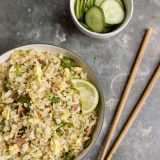Andy Ricker’s house in Thailand sits down a ragtag alley half an hour outside Chiang Mai, fronting fields of corn and eggplant. The house is teak—its wood harvested from a rice barn—and classic. The first floor is open to the elements and includes a kitchen, dining table and seating area for guests.
Upstairs the space is more European. Ricker had the warren of smaller rooms opened up to provide better airflow. A balcony looks toward the smoky mountains of Burma, to the west. The property also includes a “spirit house,” a small shed for ancestors whose spirits were displaced by construction of the main residence. It is scented with incense and gifted with offerings of food. The past is always present in Thailand.
The day before, Ricker had guided us through a maze of Chiang Mai restaurants and a barrage of dishes: grilled chicken, papaya salad, rice porridge, crispy fried wok egg, wok-seared greens, fried bananas with caramel sauce. They were all examples of Thailand’s big flavors, quick cooking and radically different culinary philosophy.
Today was reserved for private cooking lessons, including a wok-fried omelet, fried rice and kai nung (steamed chicken) with chili paste.
A word about Ricker’s kitchen. I am standing barefoot on a poured concrete floor (he had switched to flip-flops). The kitchen is open-air and small; everything is a step or two away. A series of woks and simple pans hangs from crossbeams. Two large propane burners—the countertop kind—are connected to a weathered 50-gallon tank under the eaves. Ricker’s knife of choice is a giant $10 cleaver with a scimitar-shaped blade. The granite mortar and pestle are always at hand. Many ingredients are harvested from the garden nearby, filled with lemon grass, ginger, greens, long beans and cilantro. Nearby markets sell small-breasted local chickens (with head and feet attached), fresh turmeric (red and yellow) and anything else not on hand.
I normally disparage the wok, preferring a Western-style nonstick skillet. My opinion is informed by the notion that flat stovetops are best suited to flat cooking vessels. But Ricker is having none of that heresy, and he heats his wok with a generous splash of oil. He adds small pieces of pork belly, then shallot and garlic for a brief turn. He pushes that aside and pours in a whisked egg to scramble. The rice goes in and is lightly mashed with the other ingredients. A bit of fresh tomato, a tablespoon of soy and fish sauce, a teaspoon of sugar, then cilantro and scallions to finish. Total time? Under five minutes. He made his point: The ability to move food around from hot oil to cooler sides is an advantage skillets don’t offer.
It’s less about the cooking and more about the flavoring.
Photo: Shannon Frandsen.
Back at Milk Street, I tried to deconstruct Thai cooking. Take simple ingredients (rice, chicken, greens, pork) and infuse them with chilies, galangal, lime leaves, shallot, garlic, shrimp paste, fresh turmeric, cilantro roots, sugar, lime juice, salted radish and soy, oyster and fish sauces. It’s less about the cooking and more about the flavoring, a notion perfectly suited to home cooking.
In a nod to the Western kitchen, we began our foray into Ricker’s fried rice with a large nonstick skillet. (Please use a wok if you are so equipped and have a powerful burner.) The first question was choice of meat. Ground pork was greasy, bacon too smoky, but pancetta—if culturally odd—was just right.
In a skillet, we had to reverse-engineer the process and move foods in and out, starting with the egg, then the pancetta; both are removed after cooking. Garlic, sliced scallions and shallot go in next, followed by the rice, then a mixture of fish and soy sauces with a bit of water and sugar. The egg and pancetta are added back. The fried rice is topped with minced cilantro and more scallions. Fast and perfect.
Much of Thai cooking depends on leftover rice. If you have none, follow our recipe for jasmine rice (see sidebar). Yes, day-old rice is preferable; it offers more structure and is less likely to become soft during cooking.
One other trick. Thai restaurants offer condiments, like sliced green chilies in distilled white vinegar. The simplicity of this notion was so appealing that we came up with our own: jalapenos stemmed and thinly sliced, then mixed with a blend of fish sauce and lime juice, plus a hint of sugar (see sidebar). Use it with the fried rice or just about any other dish that needs a pick-me-up.
Around sunset, we took off to photograph nearby rice paddies. When we returned, we found Ricker and and his girlfriend, Kung, sitting in the twilight with neighbors at a table nestled under a tree. We were the shadow people, not the ancestors, who, I imagined, were enjoying the conversation. You can get to know a recipe but never a place. And so Thailand’s secrets remain hidden in the back alleys, the spirit houses and under the tamarind trees. I took home the tastes and aromas, the hospitality and a few of the recipes, but that is more than enough for this lucky tourist.




